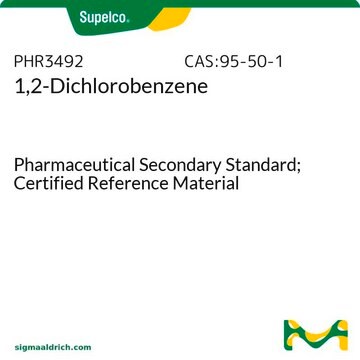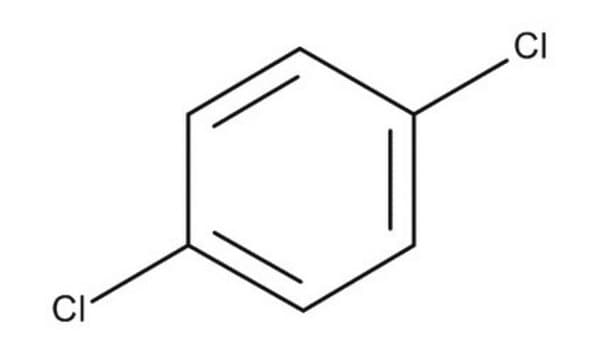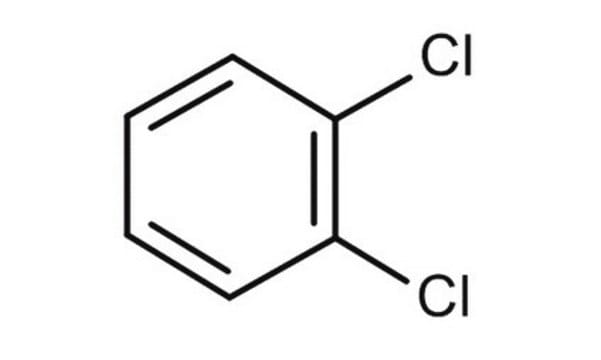35350
1,3-Dichlorobenzene
puriss., ≥99.0% (GC)
Synonym(s):
m-Dichlorobenzene
Sign Into View Organizational & Contract Pricing
All Photos(1)
About This Item
Empirical Formula (Hill Notation):
C6H4Cl2
CAS Number:
Molecular Weight:
147.00
Beilstein:
956618
EC Number:
MDL number:
UNSPSC Code:
12352100
PubChem Substance ID:
NACRES:
NA.22
Recommended Products
vapor pressure
5 mmHg ( 38.8 °C)
grade
puriss.
Assay
≥99.0% (GC)
form
liquid
refractive index
n20/D 1.546 (lit.)
n20/D 1.546
bp
172-173 °C (lit.)
mp
−25-−22 °C (lit.)
density
1.288 g/mL at 25 °C (lit.)
functional group
chloro
SMILES string
Clc1cccc(Cl)c1
InChI
1S/C6H4Cl2/c7-5-2-1-3-6(8)4-5/h1-4H
InChI key
ZPQOPVIELGIULI-UHFFFAOYSA-N
Looking for similar products? Visit Product Comparison Guide
General description
1,3-Dichlorobenzene is a thermodynamically favoured isomer of 1,4-dichlorobenzene. The heat capacity at constant pressure and density of 1,3-dichlorobenzene was measured in the temperature range from (283.15 to 353.15)K.
Application
1,3-Dichlorobenzene is suitable as carbon and energy supplement for the growth of gram-negative, peritrichously flagellated rod, tentatively identified as an Alcaligenes sp.
Signal Word
Warning
Hazard Statements
Precautionary Statements
Hazard Classifications
Acute Tox. 4 Oral - Aquatic Chronic 2
Storage Class Code
10 - Combustible liquids
WGK
WGK 2
Flash Point(F)
152.6 °F - closed cup
Flash Point(C)
67.0 °C - closed cup
Personal Protective Equipment
dust mask type N95 (US), Eyeshields, Gloves
Choose from one of the most recent versions:
Already Own This Product?
Find documentation for the products that you have recently purchased in the Document Library.
Customers Also Viewed
J Messner et al.
Chemical communications (Cambridge, England), 50(79), 11705-11708 (2014-08-22)
The isomerisation reaction of 1,4-dichlorobenzene leading to the thermodynamically favoured and technically desired 1,3-dichlorobenzene has been studied comparing highly acidic chloroaluminate melts with organic imidazolium and alkali metal ions. Interestingly, the inorganic melts show much higher reactivity and full recyclability
J A de Bont et al.
Applied and environmental microbiology, 52(4), 677-680 (1986-10-01)
A gram-negative, peritrichously flagellated rod, tentatively identified as an Alcaligenes sp., was isolated from a mixture of soil and water samples by using 1,3-dichlorobenzene as the sole carbon and energy source. During growth on 1,3-dichlorobenzene, almost stoichiometric amounts of chloride
Heat capacities and densities of some liquid chloro-, bromo-, and bromochloro-substituted benzenes.
Goralski P and Piekarski H.
Journal of Chemical and Engineering Data, 52(2), 655-659 (2007)
Violeta Simic-Milosevic et al.
Physical chemistry chemical physics : PCCP, 10(14), 1916-1920 (2008-03-28)
The constitutional isomerisation of single dichlorobenzene molecules adsorbed on the surfaces of Ag(111) and Cu(111) between their meta- and para-isomers is induced and investigated by means of a low temperature scanning tunneling microscope. On both substrates similar isomerisation thresholds are
N Yoshida et al.
Analytical chemistry, 73(18), 4417-4421 (2001-09-29)
A distributed-feedback dye laser has been developed for achieving the efficient multiphoton ionization of chlorobenzene and dichlorobenzene, that is, precursor molecules of dioxins. This tunable picosecond laser with a narrow spectral line width, that is, a nearly transform-limited pulse, provides
Our team of scientists has experience in all areas of research including Life Science, Material Science, Chemical Synthesis, Chromatography, Analytical and many others.
Contact Technical Service












